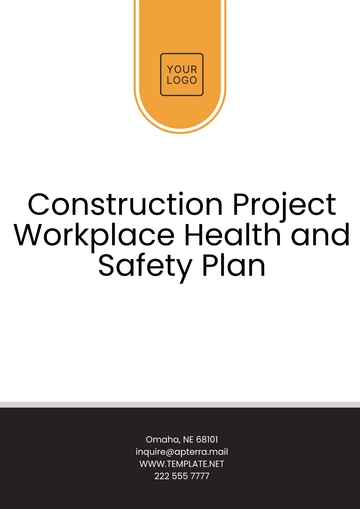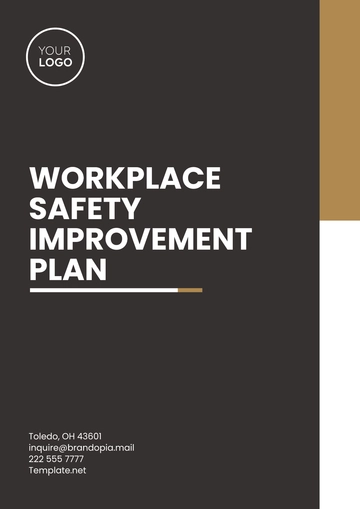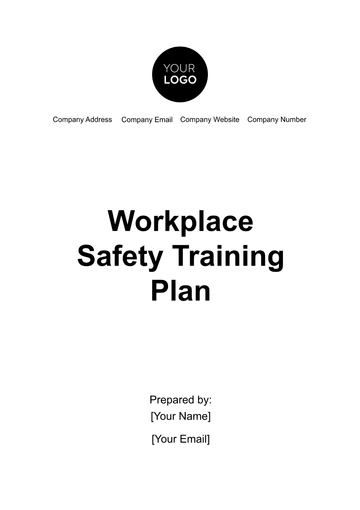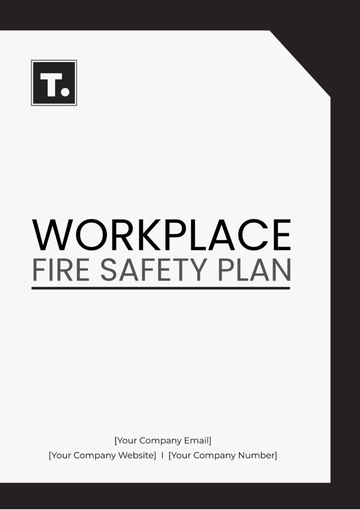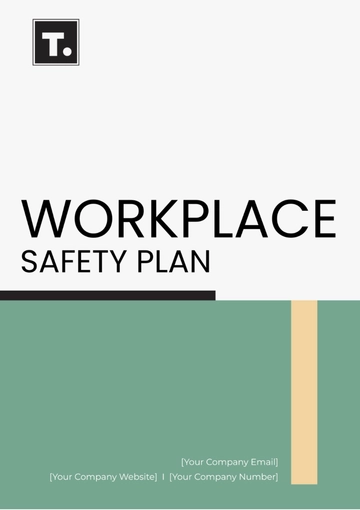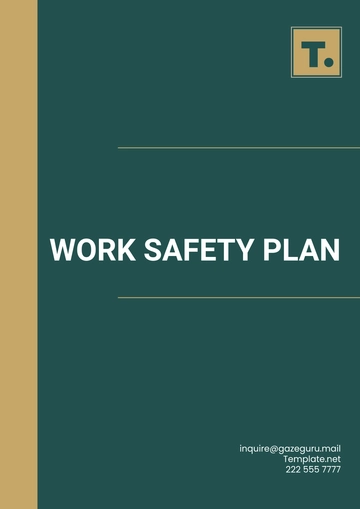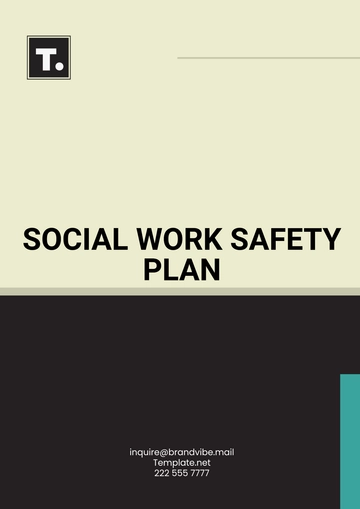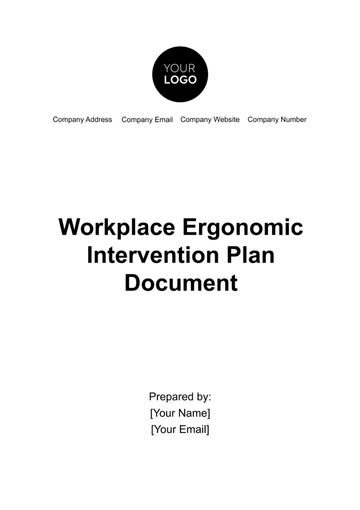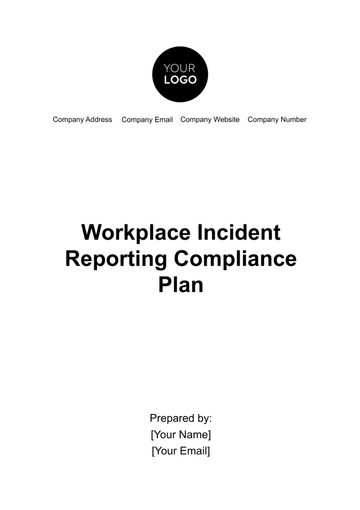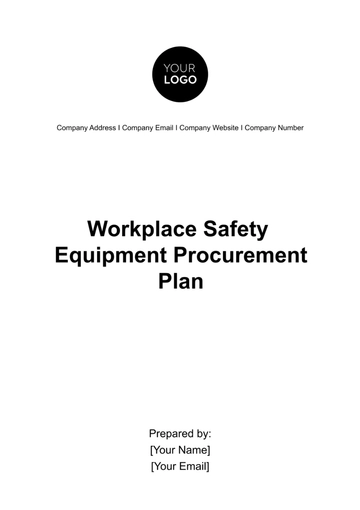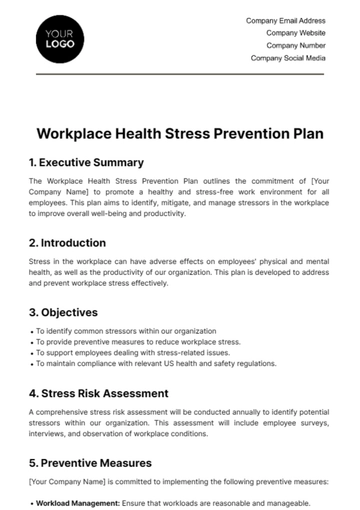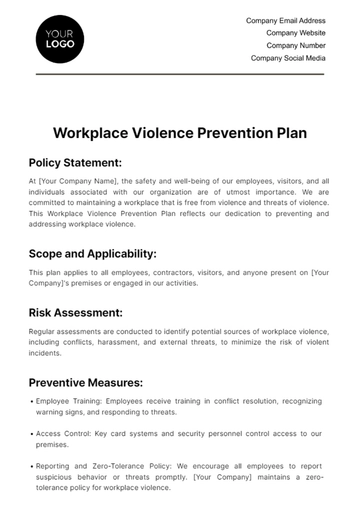Free Workplace Ergonomic Intervention Plan Document
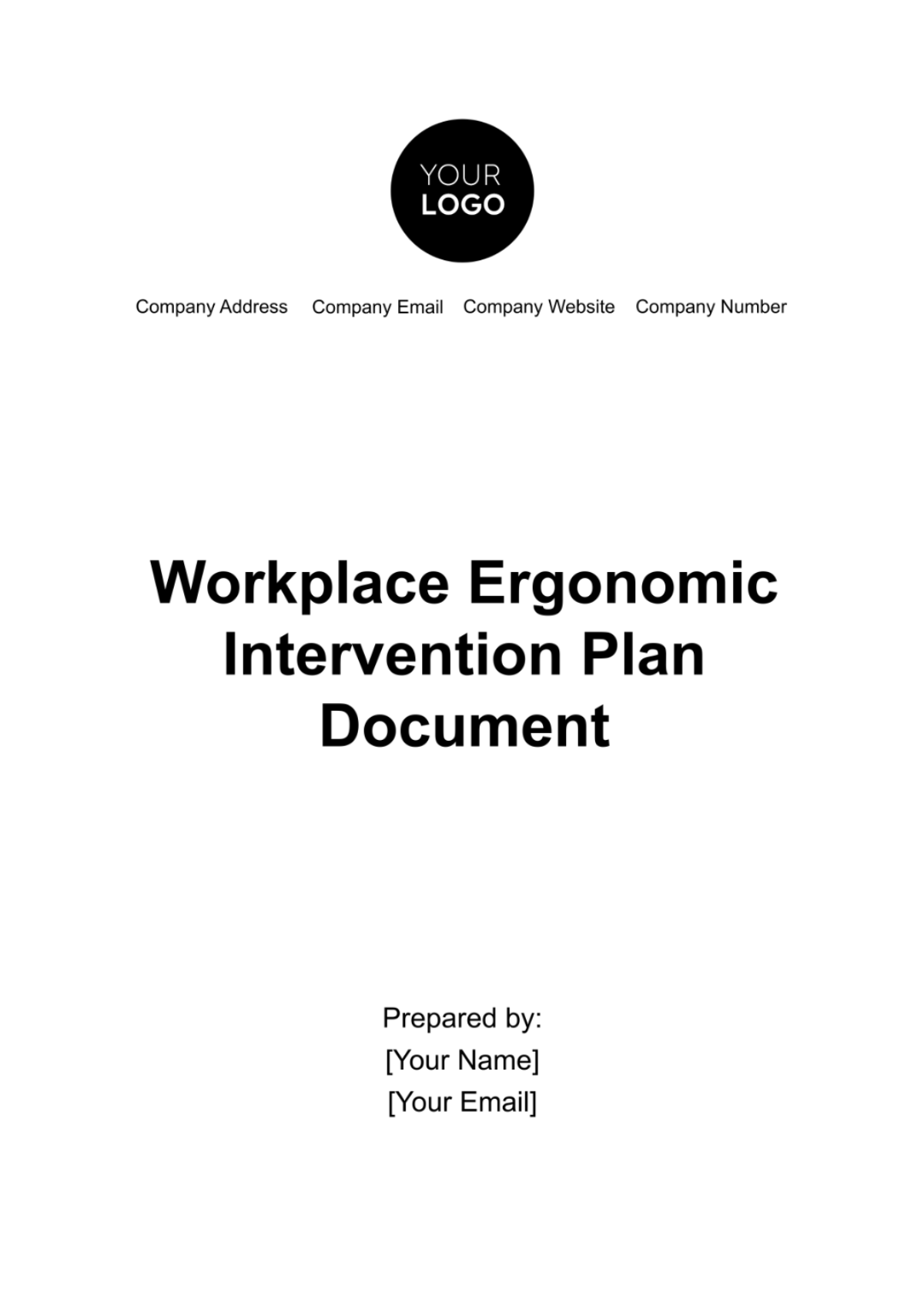
Introduction |
What is Workplace Ergonomics?
Workplace ergonomics refers to the science and practice of designing workspaces and job demands to fit the capabilities and limitations of the workforce. It encompasses optimizing office layouts, workstations, tools, and workflow processes to enhance comfort, safety, and efficiency. The importance of workplace ergonomics lies in its profound impact on employee well-being, productivity, and overall job satisfaction. By reducing the risk of injuries and strains associated with poor ergonomic conditions, we can significantly improve the quality of work life for our employees, leading to better health outcomes, increased morale, and lower rates of absenteeism.
Objectives
The primary objectives of our ergonomic intervention plan are to:
Identify and Address Ergonomic Risks: Conduct comprehensive assessments to pinpoint ergonomic risks and challenges within our workplace environment.
Implement Targeted Interventions: Develop and introduce specific ergonomic solutions tailored to address identified issues effectively.
Enhance Employee Well-being and Productivity: Through these interventions, improve the overall health, comfort, and efficiency of our employees, contributing to a more positive and productive work environment.
Foster a Culture of Ergonomic Awareness: Educate and engage employees in ergonomic practices, promoting a sustainable culture of health and safety.
Evaluate and Adapt: Continuously monitor the effectiveness of implemented interventions and make adjustments as necessary, ensuring long-term success and improvement in workplace ergonomics.
This plan is designed to be a dynamic and evolving strategy, responsive to the needs of our employees and the operational demands of our workplace. It represents our commitment to fostering a work environment that prioritizes the health and well-being of every member of our team.
Ergonomic Assessment Findings |
In this section, we present the findings from our recent ergonomic assessments, which were meticulously conducted to evaluate the various aspects of our workplace environment. These assessments have been instrumental in identifying key ergonomic issues and areas that require improvement to enhance employee well-being and productivity.
Assessment Area | Findings | Key Ergonomic Issues Identified |
Office Workstations | The majority of desks and chairs are non-adjustable; poor alignment with employee height and posture. | Inadequate adjustable furniture, leads to discomfort and potential musculoskeletal problems. |
Production Areas | Repetitive motion tasks are common; lack of supportive equipment for manual handling. | High risk of repetitive strain injuries and inadequate manual handling practices. |
IT Department | Extended use of computers with suboptimal keyboard and mouse design. | Ergonomic risks related to repetitive keyboard use and poor wrist positioning. |
Break and Common Areas | Insufficient supportive seating and areas for rest. | Lack of ergonomic rest spaces contributes to physical fatigue. |
Lighting and Acoustics | Inconsistent lighting across workspaces; high noise levels in certain areas. | Visual strain and stress due to poor environmental ergonomics. |
Ergonomic Intervention Strategies |
This section outlines the specific ergonomic interventions we propose to implement in response to the issues identified in our assessments. Each intervention is strategically designed to address the key ergonomic challenges, with a clear rationale for why these measures are expected to be effective.
1. Upgrading to Adjustable Workstations
Description: Introduction of height-adjustable desks and chairs with proper lumbar support in office workstations and common areas.
Rationale: Adjustable workstations allow for customization to individual employee needs, reducing the risk of musculoskeletal problems. This intervention directly addresses the discomfort and potential injuries caused by static and non-ergonomic furniture, enhancing comfort and productivity.
2. Ergonomic Equipment in Production Areas
Description: Implementation of ergonomic tools and equipment, such as anti-fatigue mats, adjustable workbenches, and automated lifting devices in production areas.
Rationale: These tools are designed to reduce strain from repetitive tasks and manual handling. By alleviating the physical stress of production work, we aim to decrease the incidence of repetitive strain injuries and improve overall safety and efficiency in these areas.
3. Environmental Ergonomic Improvements
Description: Revamping lighting and acoustics across the workplace, including the introduction of natural lighting solutions where possible and sound-absorbing materials in high-noise areas.
Rationale: Proper lighting reduces visual strain and enhances focus, while controlled acoustics minimize stress and distractions. These environmental changes are crucial for creating a more comfortable and health-friendly workspace, contributing to overall employee well-being and concentration.
Each of these interventions has been chosen based on a combination of ergonomic best practices and specific needs highlighted in our workplace assessments. Implementing these changes will play a significant role in creating a more ergonomically sound environment, ultimately benefiting the health, satisfaction, and productivity of our workforce.
Implementation Plan |
This section details a step-by-step guide for the implementation of our proposed ergonomic interventions, including a clear timeline and delineation of responsibilities. This structured approach ensures an organized and effective roll-out of the ergonomic improvements, with clear accountability at each stage.
Step | Timeline | Roles and Responsibilities |
Procurement of Adjustable Workstations | Month 1-2 |
|
Installation and Setup of Workstations | Month 3 |
|
Introduction of Ergonomic Equipment in Production Areas | Month 4-5 |
|
Training on Usage of New Ergonomic Tools | Month 6 |
|
Revamping Lighting and Acoustics | Month 7-8 |
|
Budget and Resources |
In this section, we outline the financial aspects of our ergonomic intervention plan, including a detailed budget allocation for each proposed intervention. Additionally, we provide a comprehensive list of the resources required, encompassing equipment, tools, and materials essential for the successful implementation of these interventions.
Intervention | Budget | Resources Required |
Adjustable Workstations | $50,000 | Height-adjustable desks and chairs, ergonomic accessories, installation services |
Ergonomic Equipment in Production Areas | $30,000 | Anti-fatigue mats, adjustable workbenches, lifting devices, employee training |
Environmental Ergonomic Improvements | $20,000 | Lighting fixtures, acoustic materials, installation services, consultant fees |
Training Programs | $10,000 | Training materials, external ergonomic consultants, venue rental (if applicable) |
Monitoring and Feedback Collection | $5,000 | Feedback collection tools, data analysis software, reporting mechanisms |
Training and Education Programs |
This section outlines our comprehensive training and education programs aimed at enhancing employees' understanding of ergonomic practices and ensuring their successful integration into the workplace. The following table provides details on the training programs, schedules, and methods for training delivery.
Training Program | Schedule | Methods for Training Delivery |
Ergonomics Basics | Quarter 1, Month 2 | In-person workshops conducted by external ergonomic consultants. |
Safe Manual Handling | Quarter 1, Month 4 | Hands-on training sessions led by experienced trainers in production areas. |
Computer Ergonomics | Quarter 2, Month 1 | Webinar-style online sessions with interactive demonstrations. |
Environmental Ergonomics | Quarter 2, Month 3 | On-site sessions combined with video presentations for environmental awareness. |
Ongoing Ergonomic Education and Support | Ongoing | Monthly newsletter updates, online resources, and access to ergonomic experts. |
These training and education programs are designed to cater to various aspects of workplace ergonomics and accommodate different learning preferences. By offering a combination of in-person, online, and hands-on sessions, we aim to ensure that employees receive comprehensive training and are well-equipped to practice ergonomic principles in their daily work routines.
Monitoring and Evaluation |
In this section, we elaborate on our strategies for monitoring the implementation of ergonomic interventions and assessing their effectiveness. We recognize that ongoing evaluation is vital for measuring the impact of our efforts and making informed decisions for continuous improvement.
Methods
Regular Site Inspections: Periodic site visits by our Health and Safety Committee to assess the physical implementation of ergonomic changes.
Feedback Mechanisms: Utilization of employee feedback mechanisms to identify real-time issues and areas needing improvement.
Performance Metrics: Tracking key performance indicators (KPIs) related to ergonomics, including injury rates, absenteeism, and productivity.
Audit of Training Records: Regular audits of training records to ensure that employees are participating in ergonomic education programs.
Review of Budget Utilization: Ongoing review of budget allocation and expenses related to ergonomic interventions.
KPIs
KPIs | Target Numbers |
Reduction in Ergonomic-Related Injuries | 25% reduction |
Employee Satisfaction with Ergonomic Setup | 80% satisfaction |
Ergonomic Training Participation Rate | 90% participation |
Compliance with Ergonomic Practices | 85% compliance |
Improvement in Overall Productivity | 15% improvement |
Decrease in Absenteeism due to Ergonomic Issues | 30% decrease |
Risk Management |
In this section, we address the critical aspect of risk management and contingency planning to ensure the smooth implementation of our ergonomic interventions. Identifying potential risks and challenges allows us to proactively develop contingency plans, ensuring that we can navigate unforeseen obstacles effectively.
Risks | Contingency Plans |
Delays in Procurement | Maintain open communication with suppliers, explore alternative sources, and adjust implementation timelines if necessary. |
Employee Resistance | Develop a robust change management strategy, increase employee involvement, and provide clear communication about the benefits of the interventions. |
Budget Overruns | Regularly monitor budget utilization and implement cost-saving measures as needed while maintaining the quality of interventions. |
Technical Issues | Engage IT support for technical challenges and have backup plans for computer-related ergonomic improvements. |
Training Delivery Challenges | Develop backup training schedules and methods, and ensure access to required resources for training sessions. |
Communication Plan |
In this section, we outline our comprehensive communication plan for effectively disseminating information regarding ergonomic interventions throughout our organization. Effective communication is essential to ensure that all employees are informed, engaged, and supportive of the changes we are implementing.
Strategies
Regular Updates and Announcements: Utilize company-wide emails, newsletters, and bulletin boards to provide regular updates and announcements about the progress of ergonomic interventions.
Departmental Briefings: Conduct department-specific briefings to ensure that employees receive tailored information related to their work areas and responsibilities.
Intranet and Online Resources: Maintain an easily accessible section on our intranet and provide online resources that employees can reference for information about ergonomic practices and changes.
Employee Engagement
Our approach to engaging and informing employees about the ergonomic changes emphasizes transparency, involvement, and support. We recognize that employee buy-in is crucial to the success of these interventions. We will:
Hold interactive town hall meetings to explain the objectives, benefits, and implementation timeline of the ergonomic interventions.
Encourage feedback and suggestions from employees, providing a platform for them to voice concerns and provide input.
Establish a dedicated helpdesk and point of contact for ergonomic-related inquiries and support.
Feedback and Continuous Improvement |
In this section, we highlight our commitment to continuously collect feedback from employees and utilize it as a driving force for the ongoing improvement of our ergonomic practices. We recognize that the active involvement of our workforce is essential in shaping the evolution of our ergonomic initiatives.
Mechanisms
Anonymous Surveys: Conduct periodic anonymous surveys to gather honest feedback on the comfort and effectiveness of ergonomic changes, ensuring that employees can express their opinions without fear of repercussions.
Health and Safety Committee: Establish a dedicated committee responsible for receiving and addressing ergonomic feedback, involving representatives from various departments.
Open Door Policy: Encourage an open-door policy for employees to approach their supervisors or HR with any ergonomic concerns or suggestions.
Process
Regular Data Analysis: Continuously analyze data on injury rates, absenteeism, and productivity to identify trends and areas for improvement.
Annual Ergonomic Assessments: Conduct annual workplace ergonomic assessments to identify evolving challenges and make necessary adjustments to our interventions.
Feedback Implementation: Actively incorporate employee feedback into our decision-making process, using it to refine ergonomic solutions and adapt to changing needs.
Training Updates: Regularly update and enhance our ergonomic training programs based on feedback and emerging best practices.
- 100% Customizable, free editor
- Access 1 Million+ Templates, photo’s & graphics
- Download or share as a template
- Click and replace photos, graphics, text, backgrounds
- Resize, crop, AI write & more
- Access advanced editor
Introducing the Workplace Ergonomic Intervention Plan Document Template from Template.net. This editable and customizable template provides a structured approach to enhance workplace ergonomics. Craft tailored intervention plans effortlessly with its user-friendly design. Fully editable in our Ai Editor Tool, it ensures seamless customization to suit your organization's unique needs. Elevate workplace comfort and productivity today!
You may also like
- Finance Plan
- Construction Plan
- Sales Plan
- Development Plan
- Career Plan
- Budget Plan
- HR Plan
- Education Plan
- Transition Plan
- Work Plan
- Training Plan
- Communication Plan
- Operation Plan
- Health And Safety Plan
- Strategy Plan
- Professional Development Plan
- Advertising Plan
- Risk Management Plan
- Restaurant Plan
- School Plan
- Nursing Home Patient Care Plan
- Nursing Care Plan
- Plan Event
- Startup Plan
- Social Media Plan
- Staffing Plan
- Annual Plan
- Content Plan
- Payment Plan
- Implementation Plan
- Hotel Plan
- Workout Plan
- Accounting Plan
- Campaign Plan
- Essay Plan
- 30 60 90 Day Plan
- Research Plan
- Recruitment Plan
- 90 Day Plan
- Quarterly Plan
- Emergency Plan
- 5 Year Plan
- Gym Plan
- Personal Plan
- IT and Software Plan
- Treatment Plan
- Real Estate Plan
- Law Firm Plan
- Healthcare Plan
- Improvement Plan
- Media Plan
- 5 Year Business Plan
- Learning Plan
- Marketing Campaign Plan
- Travel Agency Plan
- Cleaning Services Plan
- Interior Design Plan
- Performance Plan
- PR Plan
- Birth Plan
- Life Plan
- SEO Plan
- Disaster Recovery Plan
- Continuity Plan
- Launch Plan
- Legal Plan
- Behavior Plan
- Performance Improvement Plan
- Salon Plan
- Security Plan
- Security Management Plan
- Employee Development Plan
- Quality Plan
- Service Improvement Plan
- Growth Plan
- Incident Response Plan
- Basketball Plan
- Emergency Action Plan
- Product Launch Plan
- Spa Plan
- Employee Training Plan
- Data Analysis Plan
- Employee Action Plan
- Territory Plan
- Audit Plan
- Classroom Plan
- Activity Plan
- Parenting Plan
- Care Plan
- Project Execution Plan
- Exercise Plan
- Internship Plan
- Software Development Plan
- Continuous Improvement Plan
- Leave Plan
- 90 Day Sales Plan
- Advertising Agency Plan
- Employee Transition Plan
- Smart Action Plan
- Workplace Safety Plan
- Behavior Change Plan
- Contingency Plan
- Continuity of Operations Plan
- Health Plan
- Quality Control Plan
- Self Plan
- Sports Development Plan
- Change Management Plan
- Ecommerce Plan
- Personal Financial Plan
- Process Improvement Plan
- 30-60-90 Day Sales Plan
- Crisis Management Plan
- Engagement Plan
- Execution Plan
- Pandemic Plan
- Quality Assurance Plan
- Service Continuity Plan
- Agile Project Plan
- Fundraising Plan
- Job Transition Plan
- Asset Maintenance Plan
- Maintenance Plan
- Software Test Plan
- Staff Training and Development Plan
- 3 Year Plan
- Brand Activation Plan
- Release Plan
- Resource Plan
- Risk Mitigation Plan
- Teacher Plan
- 30 60 90 Day Plan for New Manager
- Food Safety Plan
- Food Truck Plan
- Hiring Plan
- Quality Management Plan
- Wellness Plan
- Behavior Intervention Plan
- Bonus Plan
- Investment Plan
- Maternity Leave Plan
- Pandemic Response Plan
- Succession Planning
- Coaching Plan
- Configuration Management Plan
- Remote Work Plan
- Self Care Plan
- Teaching Plan
- 100-Day Plan
- HACCP Plan
- Student Plan
- Sustainability Plan
- 30 60 90 Day Plan for Interview
- Access Plan
- Site Specific Safety Plan
